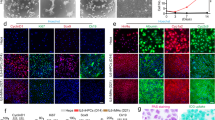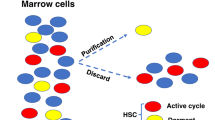Abstract
Murine embryonic stem (ES) cells are pluripotent cell lines established directly from the early embryo1,2 which can contribute differentiated progeny to all adult tissues, including the germ-cell lineage3, after re-incorporation into the normal embryo. They provide both a cellular vector for the generation of transgenic animals4 and a useful system for the identification of polypeptide factors controlling differentiation processes in early development5. In particular, medium conditioned by Buffalo rat liver cells contains a polypeptide factor, ES cell differentiation inhibitory activity (DIA), which specifically suppresses the spontaneous differentiation of ES cells in vitro, thereby permitting their growth as homogeneous stem cell populations in the absence of heterologous feeder cells6. ES cell pluripotentiality, including the ability to give rise to functional gametes, is preserved after prolonged culture in Buffalo rat liver media as a source of DIA7. Here, we report that purified DIA is related in structure and function to the recently identified haemopoetic regulatory factors human interleukin for DA cells8,9 and leukaemia inhibitory factor10. DIA and human interleukin DA/leukaemia inhibitory factor have thus been identified as related multifunctional regulatory factors with distinct biological activities in both early embryonic and haemopoetic stem cell systems.
This is a preview of subscription content, access via your institution
Access options
Subscribe to this journal
Receive 51 print issues and online access
$199.00 per year
only $3.90 per issue
Buy this article
- Purchase on SpringerLink
- Instant access to full article PDF
Prices may be subject to local taxes which are calculated during checkout
Similar content being viewed by others
References
Evans, M. J. & Kaufman, M. Nature 292, 154–156 (1981).
Martin, G. R. Proc. natn. Acad. Sci. U.S.A. 78, 7634–7638 (1981).
Bradley, A., Evans, M., Kaufman, M. H. & Robertson, E. Nature 309, 255–256 (1984).
Robertson, E. J. Trends Genet. 2, 9–13 (1986).
Heath, J. K., Smith, A. G., Wills, A. J. & Edwards J. Cell Sci. Sup (in the press).
Smith, A. G. & Hooper, M. L. Devl Biol. 121, 1–9 (1987).
Hooper, M., Hardy, K., Handyside, A., Hunter, S. & Monk, M. Nature 326, 292–2857 (1987).
Moreau, J. F. et al. Annls Inst. Pasteur, Immunol. 137, 25–37 (1986).
Moreau, J. F. et al. J. Immun. 138, 3844–3849 (1987).
Gearing, D. P. et al. EMBO J. 6, 3995–4002 (1987).
Solter, D. & Knowles, B. Proc. natn. Acad. Sci. U.S.A. 75, 5565–5569 (1978).
Moreau, J-F. et al. Nature 336, 690–692 (1988).
Gough, N. M. et al. Proc. natn. Acad. Sci. U.S.A. 85, 2623–2627 (1988).
Williams, R. L. et al. Nature 336, 684–687 (1988).
Laemmli, U. K. Nature 227, 680–685 (1970).
Mendel, C. M. & Mendel, D. B. Biochem. J. 228, 269–272 (1985).
Author information
Authors and Affiliations
Rights and permissions
About this article
Cite this article
Smith, A., Heath, J., Donaldson, D. et al. Inhibition of pluripotential embryonic stem cell differentiation by purified polypeptides. Nature 336, 688–690 (1988). https://doi.org/10.1038/336688a0
Received:
Accepted:
Issue Date:
DOI: https://doi.org/10.1038/336688a0



